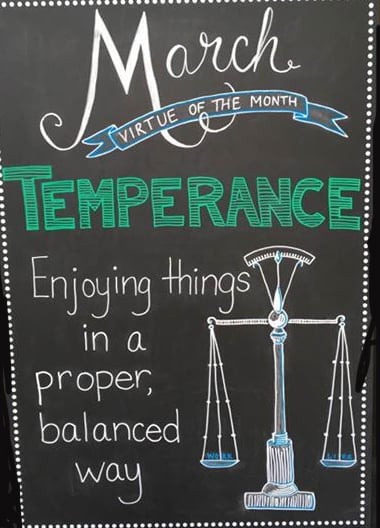
 Via Pixabay (2013), CC0 Public Domain. Text added in Picmonkey.
Via Pixabay (2013), CC0 Public Domain. Text added in Picmonkey.
“To live well is nothing other than to love God with all one’s heart, with all one’s soul and with all one’s efforts; from this it comes about that love is kept whole and uncorrupted through temperance. No misfortune can disturb it and this is fortitude. It obeys only God and this is justice and is careful in discerning things so as not to be surprised by deceit or trickery and this is prudence.” [St Augustine, De moribund eccl.1, 25, 46: PL 32, 1330-1331 and CCC 1809]
Christ’s gift of salvation offers us the grace necessary to “persevere in the pursuit of the virtue” if we desire it. To receive His grace, we must desire it, ask for it, and seek it through frequent reception of the sacraments, cooperate with the Holy Spirit, by following His calls to love what is good and shun evil.” [CCC 1811] And so the challenge to live holy lives is a worthwhile one that is deliberate. We have to desire the virtue more sincerely and to persevere in applying virtue until the time when we can join God in His eternal plan of loving goodness.” [CCC 315] This month, let’s desire, pursue, and get acquainted with the Cardinal Virtue called Temperance.
Temperance (above) is depicted as a female carrying two jugs; one contains water while the other holds wine. With her left foot she spills the wine while carefully holding onto the water jug. The statue suggests that water is vital to life rather than wine; Temperance discards the less useful wine.
 Image courtesy of University of St. Thomas. Used with permission. All rights reserved.
Image courtesy of University of St. Thomas. Used with permission. All rights reserved.
A contemporary rendition of Temperance (above) hangs in the University of St Thomas, St Paul MN. This Balma fresco features Temperance, again a woman, walking purposefully past decoys that dare to persuade her to indulge in the offerings of vice. They include gluttony and materialism (represented by the pig); idleness (represented by the grasshopper watching TV); insobriety (represented by the satyr offering drugs in a bag); adulation of rock stars (represented by the rock star siren); hypocrisy (represented by the monkey); and deceit and revenge (represented by the wolf dressed in cleric’s robes, presenting the olive branch with one hand while concealing a knife in the other hand behind his back). Temperance is neither distracted or persuaded by these decoys displaying virtuous self restraint. The fresco depicts just six types of vice; however they represent all vice that opposes Temperance. An article on the university website explains Temperance and the art work using the following testimony of a former student.
“I have graduated from St. Thomas and I am a law student at William Mitchell College of Law and a part-time law clerk at the Minneapolis City Attorney's Office. I now fully understand what temperance is and I can fully appreciate it. I remember speaking that day, and saying great things about what I thought temperance was from the perspective of a 19 year-old college student. I just want you to know that truly I am that stoic woman walking amid that fantastic forest filled with strange beasts, in 1998 I became the first college graduate in my family (maternal and paternal), I conquered the distractions of poverty, the gangs, the drugs and the crime to give a future to myself, my child and all of the children in my family who look up to me. I was tempted millions of times to give up, but I refused. I was tempted by drugs and the underworld lifestyle....But I fought against all of these things and I almost didn't make it, but now my feet are planted on firm ground and I can say that I truly understand what temperance is about.”
Can any of us fortify ourselves with Temperance through sheer will power alone? Where does Temperance come from? How does one ‘get it’?
Let’s begin by examining what Temperance is not. Many people presume that Temperance is synonymous with abstinence. Even the two works of art depict Temperance as the virtue of avoidance or abstinence as does the former student’s written testimony. However, it would probably be very difficult to depict self control, self restraint, or moderation because of its lack of absoluteness. Even the Temperance Movement of the late 18th and 19th centuries named their organization after the Cardinal Virtue while mainly calling for the prohibition or complete abstinence from alcohol within homes and business establishments. This blurring of the definition about Temperance has probably existed for a long time. So, its time to clear up this common misunderstanding about Temperance.
It is important to recognize what Temperance is. Temperance guides us in the setting of honorable limits to honorable human behaviors and activities. [CCC 1809] Temperance is simply a disposition of the mind which binds the passion according to St. Thomas Aquinas. Furthermore, when coupled with the other pivotal (cardinal) human virtues, Temperance allows us to “govern our acts, order our passions and guide our conduct in accordance with reason and faith. Temperance ensures the will’s mastery over instincts and keeps desire within the limits of what is honorable.” [CCC1809, p. 869] The most obvious companion virtues to Temperance include forgiveness, humility, prudence, charity, and justice. Virtue always fosters more virtue. Therefore it is in our best interests to strive to put on this virtue in order to preserve that which is beautiful and loving and meaningful. We need to recognize that the “struggle against carnal covetousness [concupiscence] entails purifying the heart and practicing Temperance. Remain simple and innocent and you will be like little children who do not know the evil that destroy us man’s life.” [CCC 2517]
How true is this last statement. Most of us are well aware of the negative consequences to marriage and family life if a spouse fails to have self control or lacks the ability to constrain “carnal” desires. One’s lack of Temperance introduces infidelity, addictions, distrust, and other vice into the marriage and/or family life corrupting everything that was originally beautiful and loving. The lack of virtue also disaffects other types of personal responsibilities, including one’s ability to work productively or to positively contribute to one’s society and community at large. Intemperance readily destroys/devours love and replaces it with lust, hate, ugliness and hurt. Temperance is critical to teach and practice for many good reasons. It also needs to be said that Temperance is not about setting limits to intrinsically immoral activities or behaviors. Deciding to commit moral sin only occasionally has nothing to do with Temperance. Any mortal sin only makes room for more vice which corrupts good moral character. Mortal sin does not promote virtue; it opposes it. Whenever we persuade ourselves to do something that we know is wrong, or do something to excess knowing that it is also wrongheaded, we should realize that our sense passions are playing tug of war with our rational brain — the intellect and our will — and that they just won! The consequence: vice got another toehold in our heart.
What opposes Temperance? Vice that naturally accompanies intemperance include those depicted in the artists’ rendition of Temperance; in addition, drunkenness, lust, carelessness, wastefulness, greed, hedonism, unreasonableness, brutality, indulgence, and rashness are natural companions to intemperance. Vice accumulates readily and easily; the only antidote is the opposing virtues. And unlike vice, not one of us can ever have too much virtue! Each virtue is a pearl of great value — so let’s seek it and treasure it.
How do we put on Temperance? Temperance comes to us several ways. First we have to desire it or at least desire the positive results/effects of Temperance. Then we have to evaluate our own activities and see if they measure up to level of moral living. When in doubt about how to set honorable limits to specific activities, or lack understanding about what constitutes an honorable activity, we can and should seek advice from trusted advisors including spiritual directors, our spouse, family members, friends, spiritual writings/books and clergy. I have included a Time Pyramid exercise at the end of this article that may help you determine if you are spending too little or too much time on certain activities. This will help you evaluate how well you practice Temperance in smaller matters. When evaluating how well we are living virtuous lives, we have to set aside emotions and look at how and why we do things rationally. We also have to be patient with ourselves as we learn more about Temperance. Bury the coulda, woulda, shoulda voice that accuses you of intemperance or other vice. Rather, forge ahead with new plans and intentions after giving Temperance your attention, desire, personal reflection, rational thought, and careful discernment. Our first attempt to focus on a deliberate endeavor will always seem inadequate; however, that’s how the process of putting on virtue begins. Few of us jump off the 20-meter high board before first learning to swim or learning the proper mechanics of a high dive into a pool.
Do we set our own honorable limits to our own honorable activities? Yes, your conscience will guide you through the process. It’s not as subjective as it may seem because Temperance is inextricably linked to loving God and neighbor authentically. This requires that we begin purifying our hearts so that we are able to see God “face to face and be like him.” [CCC2 519] Purifying our hearts enables us to put on virtue and tune into God’s love. We begin to see as God sees. “Therein lies the connection between purity of heart, body and faith.” [CCC2518] When we pursue Temperance on our own and without giving thought to its necessary connection to God’s grace; the temperance we put on will be less authentic because it will be humanly inspired — which could also mean that it is tainted because of our natural human desires/passions more than we realize.
Parents are vital in the formation of their children with regard to the practice of any virtue. St. Bernard reminds us that children have more capacity to learn virtue than do adults. Therefore, children can learn how to discern honorable limits and honorable activities in a childlike fashion. A spoiled child is one who has not been taught how to discern honorable limits and honorable activities in a childlike fashion. Rather he or she is allowed to practice self-indulgence rather than self-denial (Temperance) with some regularity. Parents are key to helping their children learn balance even at young ages. Children can learn how to put on virtue through sharing of their toys or possessions generously. They put on virtue by learning when to play and when to set aside play time for doing work around the home, helping others, etc. They learn Temperance by having limits set with regard to asking for things they don’t need. They also learn the virtue by being taught what is too much candy, dessert, or other sweet things. They learn virtue by agreeing to eating balanced meals. They learn about Temperance when taught matters of faith. They learn the virtue as they practice loving others over self. They learn Temperance when they have to limit time spent playing video games or using their favorite systems. They learn the virtue when they are taught to curb their desires for the next greatest new item or thing — clothes, games, toys, shoes, etc. They learn about Temperance when they learn to worship God rightly. They learn the virtue when taught how to appreciate the blessings they have been given — life, health, love, family, etc.
Adults on the other hand, have less capacity and time to learn virtue; however, its never too late to start. Temperance applies to all activities that we exercise within the sphere of our spiritual, economic, mental and psychological, intellectual, social and physical wellbeing. Learning to exercise virtue in each of these areas is a big deal. Our children look to our example of virtuous living. Society looks to us too but not with a whole lot of affirmation even though it hopes that we produce a generation of loving, caring adults for the future.
You have probably heard this ditty: God writes straight with crooked lines. I understand this (within the context of an article about virtue) to mean that God invites us all to live virtuous lives from the moment of our Baptism - that’s the straight line. However, most of us live rather crookedly — all the while being watched over and loved by a patient God. Jesus taught us that no one comes to the Father but by me. [John 14:6-7] And so, if we desire salvation, we have to first desire holiness. Then we have to decide to pursue it by climbing out of the raging waters of sin that threaten to pull us under. (St Catherine of Sienna) Then we have to abandon sin and pursue virtue by crossing the bridge that allows us to enter into the divine life of God’s only son Jesus Christ. [Source: Bishop Robert Barron. The Pivotal Players, p. 21] While our journey forward will always be a bit crooked, but as long as it leads forward to salvation we are in good hands.
Ending on a lighter note, I hope you laugh at this joke about Temperance. “With great expression the pastor said, "If I had all the beer in the world, I'd take it and throw it into the river. With even greater emphasis the pastor said, And if I had all the wine in the world, I'd take it and throw it into the river. And then finally, he said, And if I had all the whiskey in the world, I'd take it and throw it into the river. He sat down. The song leader then announced: ”For our closing song, let us sing Hymn # 365, "Shall We Gather at the River.” [Source: http://www.joke-of-the-day.com/jokes/temperance]
What can do to arm ourselves with Temperance?
- Pray for good judgement and help in discerning honorable limits to honorable human activities. Pray for help in discovering if/when you attempt to set dishonorable (immoral) limits to honorable behaviors. Pray for help in avoiding the setting of any dishonorable limits to dishonorable behaviors.
- Pray for your children that they may be gifted with good judgement and the ability to discern these same situations.
- Write a short paragraph about what Temperance means to you; read it to your children.
- Use the worksheet to evaluate activities you do that affect/disaffect your physical, social, mental and psychological, spiritual, intellectual, and economic wellness.
- What virtues are natural companions to Temperance? What vices oppose Temperance?
- What grade do you give yourself for Temperance in each of the above wellness factors? Set new limits if necessary.
- Avoid activities that corrupt your love of God and others.
- Be thankful to God for your life.
- Pray for humility and the ability to forgive.
- Pledge to love God with all your heart and mind and soul and to love others as yourself.
- Teach your children about Temperance. Help them practice Temperance.
- Set new limits for yourself and your family as needed.
Download the printable worksheet to help you manage your time with Temperance.
Copyright 2017 Linda Kracht
About the Author

Linda Kracht
Linda is a wife, mother of seven, and grandmother of 23. Linda is founder of Fortifying Families of Faith, LLC and her books include: Daughters Forever, Sons Forever; The Art of Breastfeeding, published by the Couple to Couple League; Mothers Forever, Fathers Forever; Surviving College; Black and White; and A Book for All Seasons.




.png?width=1806&height=731&name=CatholicMom_hcfm_logo1_pos_871c_2728c%20(002).png)
Comments